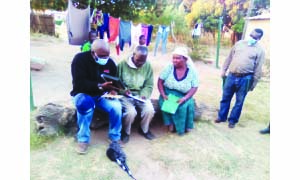
By JOWIT SALUSEKI-
BACK in the days, working in the mines was considered to be one of the most enviable jobs for those who trekked to live and work on the Copperbelt.
Mining areas such as Chibuluma, Chambishi, Kitwe, Kalulushi, Mufulira and Luanshya attracted a good number of people who flocked to the Copperbelt to look for jobs in the mining sector.
For some former miners, stories of eating local buns commonly referred to as ‘Kampompo’ and attending communal meetings in township welfare halls attracted them to the Copperbelt.
Welfare halls were places were miners congregated for a beer when they knocked off after more than six hours of working underground.
Still, others relive the days when technology was not as advanced as it is today, which, in the forgone days, led to increased incidents of occupational accidents in the mining industry.
Among such former miners who are still living to relive the old times to the current generation is Jacob Mwape, 95, of Samfya district in Luapula Province.
Mr Mwape said he worked in the mines for several years before he got was injured in 1953 while working for Rokana Mine in Kitwe.
He lost all his left fingers.
Another ex-mine is Constanino Bwalya of Mungwi district in Northern Province.
Mr Bwalya, who was born in 1931, used to work in the mining sector in Chingola before an accident on March 10, 1960, cut short his career.
“It was good working in the mines back then because everyone who migrated to the Copperbelt always wanted to join the mines … which were among the biggest employers,” Mr Bwalya said.
He said after the accident, his left leg was amputated.
Fortunately for him, the Workers Compensation Fund Control Board (WCFCB) is going to construct a house for him.
Mr Bwalya is among the 90 highly dependent beneficiaries whom the board has already started constructing houses for in different parts of the country.
Marcel Saili, another ex-miner of Kasama district, also has fond memories of working in the mines which were under the Zambia Consolidated Copper Mines (ZCCM).
Mr Saili said working in the mines at the time was very exciting despite the fact that at the time, there was less investment in mechanization.
“We enjoyed doing our work despite the low wages that we were getting compared to this time. The good part is that each and every miner was motivated to work,” Mr Saili said with chuckle.
Mr Saili, who used to work for Chambishi Open Pit Mine, said he worked for more than 20 years before he was involved in an occupational accident in 1972.
He was put on early retirement in 1977.
Clement Mboni of Mpika district in Muchinga Province remembers the old days of working as a machine operator at Mufulira Mine.
“It was always a joyous moment to knock off with two or three loaves of buns which we called ‘kampompo’,” Mr Mboni said.
He said he worked for 25 years before going into early retirement on March 13, 1990.
“While working as a machine operator, I was transferred to be in charge of the wagons when the train hit me, which led to my being put on early retirement,” Mr Chitulika said in te company of his wife at their Chatulika home in Mpika.
He said he go K120 as his early retirement package.
Stephen Mwape , also of Mpika, recalled the years he worked in the mines on the Copperbelt until he was laid off after suffering from an occupational accident in 1976.
It is worth recalling that the Zambian copper mining industry as we know it today had its genesis in the 1920s.
Consistent private sector-driven investment in the industry over a period of over 50 years in exploration has resulted in mine development.
This resulted in copper production rising to a peak of 769,000 tonnes in 1969, which providing over 62,000 direct jobs.
The industry was nationalized in 1973 and remained in Government hands for just over 24 years.
During this period, the industry experienced a serious decline in production levels, reaching the lowest level in the year 2000 when production was 250,000 tonnes.
An average of just under 2,000 jobs were lost every year in the 24-year period, reaching just over 22,000 direct jobs in 2000.
Following the return of Zambian politics to pluralism and liberalised economic policies, the Government decided to privatize the mining industry.
The process started in 1996 and by the year 2000, all the mining assets had been privatized.
The new investors embarked on serious investment to upgrade the assets and to develop Greenfield mining projects.
Years later and after more than US$12 billion investment, production levels in recent times increased year-on-year to a peak of 763,000 in 2013, with direct jobs reaching 90,000.
Although it is the desire of the Zambian Government to diversify the economy, the copper mining industry will remain the engine that will drive this diversification for a long time to come.
In the work done by International Council on Metals and Mining (ICMM), verified data from 2016 statistics shows that, in that year, over 75 per cent of the Foreign Direct Investment (FDI) that came into Zambia was due to the mining industry.
In addition, about 80 per cent of the country’s export earnings came from the mining industry, as well as over 25 per cent of all revenues collected by Government.
The mining industry contributed more than 10 per cent to the Gross domestic Product (GDP), and more than five per cent of all formal employment.
These parameters show that Zambia’s reliance on the mining industry is way above that of other similar countries in terms of their dependence on the extractive industries.
With new mines in North Western Province, the mining sector will continue to be one of the biggest employers in Zambia.






